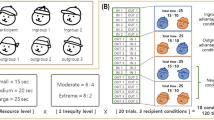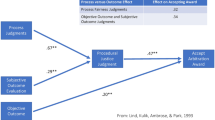Abstract
These studies were designed to assess ethnocentrism and stereotypes as possible mediators of intergroup fairness biases. In Study 1, subjects wrote fair and unfair behaviors about their own sex (the ingroup) and the opposite sex (the outgroup). More fair and fewer unfair behaviors were written about the ingroup than about the outgroup, supporting the ethnocentric hypothesis. In Study 2, subjects rated the fairness and frequency of random samples of each item type. Half the subjects rated these items as they were originally written, and half rated them with the gender of the actor reversed. Ethnocentrism was evident in ratings of ingroup actors as more fair than outgroup actors when both performed fair behaviors, but this bias was reversed in favor of outgroup actors for ratings of unfair behaviors. In addition, the items written about women were rated more fair than those written about men, and men rated the reversed gender items less fair and less frequent than did women, supporting the influence of gender stereotypes in intergroup fairness biases.
Similar content being viewed by others
References
Bem, S. L. (1974). The measurement of psychological androgyny.J. Consult. Clin. Psychol. 42: 155–162.
Bradley, G. W. (1978). Self-serving biases in the attribution process: A reexamination of the fact or fiction question.J. Pers. Soc. Psychol. 36: 65–71.
Brewer, M. B. (1979). In-group bias in the minimal intergroup situation: A cognitive-motivational analysis.Psychol. Bull. 86 307–324.
Crocker, J., and Schwartz, I. (1985). Prejudice and ingroup favoritism in a minimal intergroup situation: Effects of self-esteem.Pers. Soc. Psychol. Bull. 11: 379–386.
Eagly, A. H. (1983). Gender and social influence: A social psychological analysis.Am. Psychol. 38: 971–981.
Hamilton, D. L. (ed.). (1981).Cognitive Processes in Stereotyping and Intergroup Behavior, Lawrence Erlbaum, Hillsdale, NJ.
Jussim, L., Coleman, L. M., and Lerch, L. (1987). The nature of stereotypes: A comparison and integration of three theories.J. Pers. Soc. Psychol. 53: 536–546.
Kelly, H. H. (1972).Causal Schemata and the Attribution Process, General Learning Press, Morristown, NJ.
Liebrand, W. B. G., Jansen, R. W. T., Rijken, V. M., and Sugre, C. J. M. (1986). Might over morality: Social values and the perception of other players in experimental games.J. Exp. Soc. Psychol. 22: 203–215.
Liebrand, W. B. G., Messick, D. M., and Wolters, F. J. M. (1986). Why we are fairer than others: A cross-cultural replication and extension.J. Exp. Soc. Psychol. 22: 590–604.
Messick, D. M., Bloom, S., Boldizar, J. P., and Samuelson, C. D. (1985). Why we are fairer than others?J. Exp. Soc. Psychol. 21: 480–500.
Messick, D. M., and Sentis, K. P. (1983). Fairness, preference, and fairness biases. In Messick, D. M., and Cook, K. (eds.),Equity Theory: Psychological and Sociological Perspectives, Praeger, New York, pp. 61–94.
Miller, D. T., and Ross, M. (1975). Self-serving biases in the attribution of causality: Fact or fiction?Psychol. Bull. 82: 213–225.
Stephan, W. G. (1985). Integroup Relations. In Lindzey, G., and Aronson, E. (eds.),The Handbook of Social Psychology, Vol. 2, Random House, New York, pp. 599–658.
Tabachnik, N., Crocker, J., and Alloy, L. B. (1983). Depression, social comparison, and the false concensus effect.J. Pers. Soc. Psychol. 45: 688–689.
Taylor, S. E., and Fiske, S. T. (1978). Salience, attention, and attribution: Top of the head phenomena. In Berkowitz, L. (ed.),Advances in Experimental Social Psychology, Vol. 10, Academic Press, New York.
Author information
Authors and Affiliations
Rights and permissions
About this article
Cite this article
Boldizar, J.P., Messick, D.M. Intergroup fairness biases: Is ours the fairer sex?. Soc Just Res 2, 95–111 (1988). https://doi.org/10.1007/BF01048501
Issue Date:
DOI: https://doi.org/10.1007/BF01048501




